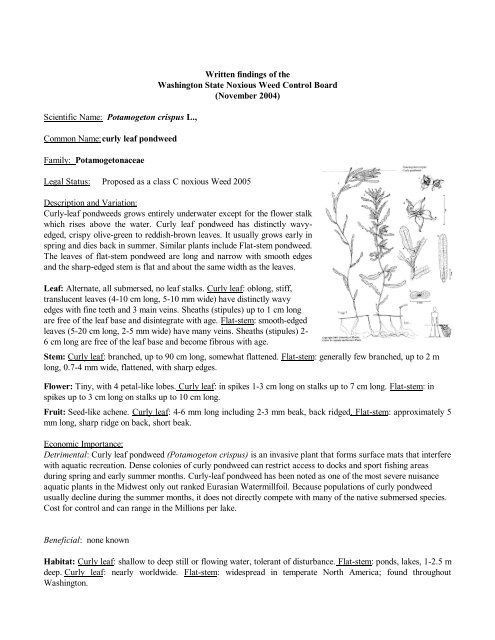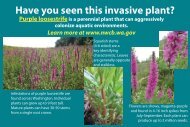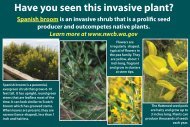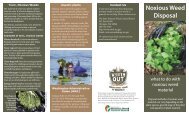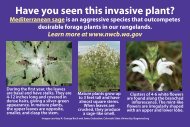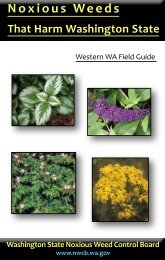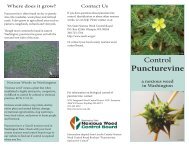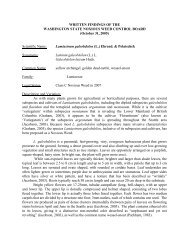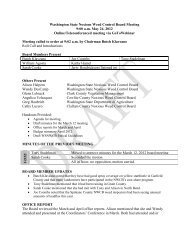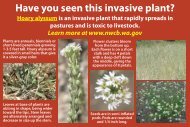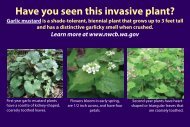written findings of the - Washington State Noxious Weed Control Board
written findings of the - Washington State Noxious Weed Control Board
written findings of the - Washington State Noxious Weed Control Board
Create successful ePaper yourself
Turn your PDF publications into a flip-book with our unique Google optimized e-Paper software.
Scientific Name: Potamogeton crispus L.,<br />
Common Name: curly leaf pondweed<br />
Family: Potamogetonaceae<br />
Written <strong>findings</strong> <strong>of</strong> <strong>the</strong><br />
<strong>Washington</strong> <strong>State</strong> <strong>Noxious</strong> <strong>Weed</strong> <strong>Control</strong> <strong>Board</strong><br />
(November 2004)<br />
Legal Status: Proposed as a class C noxious <strong>Weed</strong> 2005<br />
Description and Variation:<br />
Curly-leaf pondweeds grows entirely underwater except for <strong>the</strong> flower stalk<br />
which rises above <strong>the</strong> water. Curly leaf pondweed has distinctly wavyedged,<br />
crispy olive-green to reddish-brown leaves. It usually grows early in<br />
spring and dies back in summer. Similar plants include Flat-stem pondweed.<br />
The leaves <strong>of</strong> flat-stem pondweed are long and narrow with smooth edges<br />
and <strong>the</strong> sharp-edged stem is flat and about <strong>the</strong> same width as <strong>the</strong> leaves.<br />
Leaf: Alternate, all submersed, no leaf stalks. Curly leaf: oblong, stiff,<br />
translucent leaves (4-10 cm long, 5-10 mm wide) have distinctly wavy<br />
edges with fine teeth and 3 main veins. Sheaths (stipules) up to 1 cm long<br />
are free <strong>of</strong> <strong>the</strong> leaf base and disintegrate with age. Flat-stem: smooth-edged<br />
leaves (5-20 cm long, 2-5 mm wide) have many veins. Sheaths (stipules) 2-<br />
6 cm long are free <strong>of</strong> <strong>the</strong> leaf base and become fibrous with age.<br />
Stem: Curly leaf: branched, up to 90 cm long, somewhat flattened. Flat-stem: generally few branched, up to 2 m<br />
long, 0.7-4 mm wide, flattened, with sharp edges.<br />
Flower: Tiny, with 4 petal-like lobes. Curly leaf: in spikes 1-3 cm long on stalks up to 7 cm long. Flat-stem: in<br />
spikes up to 3 cm long on stalks up to 10 cm long.<br />
Fruit: Seed-like achene. Curly leaf: 4-6 mm long including 2-3 mm beak, back ridged. Flat-stem: approximately 5<br />
mm long, sharp ridge on back, short beak.<br />
Economic Importance:<br />
Detrimental: Curly leaf pondweed (Potamogeton crispus) is an invasive plant that forms surface mats that interfere<br />
with aquatic recreation. Dense colonies <strong>of</strong> curly pondweed can restrict access to docks and sport fishing areas<br />
during spring and early summer months. Curly-leaf pondweed has been noted as one <strong>of</strong> <strong>the</strong> most severe nuisance<br />
aquatic plants in <strong>the</strong> Midwest only out ranked Eurasian Watermillfoil. Because populations <strong>of</strong> curly pondweed<br />
usually decline during <strong>the</strong> summer months, it does not directly compete with many <strong>of</strong> <strong>the</strong> native submersed species.<br />
Cost for control and can range in <strong>the</strong> Millions per lake.<br />
Beneficial: none known<br />
Habitat: Curly leaf: shallow to deep still or flowing water, tolerant <strong>of</strong> disturbance. Flat-stem: ponds, lakes, 1-2.5 m<br />
deep. Curly leaf: nearly worldwide. Flat-stem: widespread in temperate North America; found throughout<br />
<strong>Washington</strong>.
Geographic Distribution: Native to Eurasia, Africa, and Australia, this<br />
species has been found in most <strong>of</strong> <strong>the</strong> United <strong>State</strong>s since 1950<br />
<strong>Washington</strong> Distribution: Found in<br />
History: Curly pondweed, Potamogeton crispus L., is native to Eurasia<br />
and apparently was introduced into <strong>the</strong> United <strong>State</strong>s in <strong>the</strong> mid 1800’s<br />
(Stuckey 1979). Prior to 1900, <strong>the</strong> distribution <strong>of</strong> P. crispus was <strong>the</strong><br />
nor<strong>the</strong>astern United <strong>State</strong>s. By 1930 curly pondweed had spread westward<br />
to several states <strong>of</strong> <strong>the</strong> Great Lakes region. The species has since spread<br />
across much <strong>of</strong> <strong>the</strong> United <strong>State</strong>s, presumably by migrating waterfowl, intentional planting for waterfowl and<br />
wildlife habitat, and possibly even as a contaminant in water used to transport fishes and fish eggs to hatcheries<br />
(Stuckey 1979).<br />
Growth and Development: Curly pondweed perennial, rooted, submersed aquatic vascular plant that produces<br />
seed, but <strong>the</strong> importance <strong>of</strong> seed in <strong>the</strong> spread and maintenance <strong>of</strong> populations is unknown (Stuckey 1979) and is<br />
assumed to be less important than turions (Sastroutomo 1981). In most portions <strong>of</strong> its range, Potamogeton<br />
crispus typically reaches peak biomass in <strong>the</strong> late spring or early summer months, forms turions, <strong>the</strong>n declines<br />
and "survives" <strong>the</strong> warmer months in a dormant state (i.e., as a turion) (Cypert 1967, Stuckey 1979, Sastroutomo<br />
1981, Tobiessen and Snow 1984, Nichols and Shaw 1986). As water temperatures cool during <strong>the</strong> late summer<br />
or fall months, <strong>the</strong> turions germinate, grow through <strong>the</strong> winter months with <strong>the</strong> plants reaching peak biomass in<br />
<strong>the</strong> spring before most o<strong>the</strong>r submersed macrophytes begin <strong>the</strong>ir growth cycle. Once established, <strong>the</strong> plants<br />
regrow and form colonies from rhizomes.<br />
Curly leaf pondweed has a unique life cycle which gives it competitive advantages over many native aquatic plants.<br />
Unlike most native plants, curly leaf pondweed may be in a photosyn<strong>the</strong>tically active state even under thick ice and<br />
snow cover (Wehrmeister and Stuckey, 1978). Therefore, it is <strong>of</strong>ten <strong>the</strong> first plant to appear after ice out. By late<br />
spring it can form dense mats which may interfere with recreation and limit <strong>the</strong> growth <strong>of</strong> native aquatic plants<br />
(Catling and Dobson, 1985). Curly leaf plants usually die back in early summer in response to increasing water<br />
temperatures, but <strong>the</strong>y first form vegetative propagules called turions (hardened stem tips). New plants sprout from<br />
turions in <strong>the</strong> fall (Catling and Dobson, 1985).<br />
<strong>Control</strong>:<br />
Chemical - active ingredients that have been successful in treating curly-leaf pondweed include diquat (G), copper<br />
with diquat (G), endothall (E), and fluridone (E). E = excellent, G = good<br />
Reward is a liquid diquat formulation that has been effective on curly-leaf pondweed and is more effective<br />
if mixed with a copper compound. It is a contact herbicide. Contact herbicides act quickly and kill all plants cells<br />
that <strong>the</strong>y contact.<br />
Cutrine Plus, K-Tea, Captain, Algae Pro, Clearigate are all chelated or compound copper herbicides and<br />
can be used in a mixture with Reward or Aquathol K. O<strong>the</strong>r chelated or compound copper formulations are<br />
available but are not linked to this web site.<br />
Aquathol, Aquathol K, and Aquathol Super K are dipotassium salts <strong>of</strong> endothall and comes in both<br />
liquid and granular formulations. These endothall products have been effective on curly-leaf pondweed and can be<br />
mixed with copper compounds for additional effectiveness. Contact herbicides act quickly and kill all plants cells<br />
that <strong>the</strong>y contact. This herbicide has been found to be an effective and ideal method. If applied in early spring,<br />
Aquathol K will not harm <strong>the</strong> native plants since curly-leaf is <strong>the</strong> first plant to grow in <strong>the</strong> spring. It dissipates<br />
quickly leaving no residue and does not bio-accumulate in fish or hydro-soil. This treatment should kill curly-leaf,<br />
reduce or eliminate seed and turion production in <strong>the</strong> treated areas, and have less negative impact on native plants<br />
than treatments done later in summer.<br />
2
Hydrothol 191 is an alkylamine salt <strong>of</strong> endothall and comes in both liquid and granular formulations. It is<br />
a contact herbicide and has been effective on curly-leaf pondweed. Contact herbicides act quickly and kill all plants<br />
cells that <strong>the</strong>y contact. Hydrothol can be toxic to fish.<br />
Sonar and Avast are fluridone compounds, come in both liquid and granular formulations, and have been<br />
effective on curly-leaf pondweed. These are broad spectrum, systemic herbicides. Systemic herbicides are<br />
absorbed and move within <strong>the</strong> plant to <strong>the</strong> site <strong>of</strong> action. Systemic herbicides tend to act more slowly than contact<br />
herbicides.<br />
One danger with any chemical control method is <strong>the</strong> chance <strong>of</strong> an oxygen depletion after <strong>the</strong> treatment caused by<br />
<strong>the</strong> decomposition <strong>of</strong> <strong>the</strong> dead plant material. Oxygen depletions can kill fish in <strong>the</strong> pond. If <strong>the</strong> pond is heavily<br />
infested with weeds it may be possible (depending on <strong>the</strong> herbicide chosen) to treat <strong>the</strong> pond in sections and let each<br />
section decompose for about two weeks before treating ano<strong>the</strong>r section. Aeration, particularly at night, for several<br />
days after treatment may help control <strong>the</strong> oxygen depletion.<br />
One common problem in using aquatic herbicides is determining area and/or volume <strong>of</strong> <strong>the</strong> pond or area to be<br />
treated<br />
The mechanical and physical control methods have been used with minimal success for <strong>the</strong> management <strong>of</strong> curly<br />
leaf pondweed. These methods include: Benthic Barrier, Drawdown, Dredging/Sediment Removal, Hand Removal,<br />
Harvesting Rotovation, Shading/Light Attenuation<br />
Aquashade is a non-toxic dye or colorant. It prevents or reduces aquatic plant growth by limiting sunlight<br />
penetration, similar to fertilization. However, Aquashade does not enhance <strong>the</strong> natural food chain and may<br />
suppress <strong>the</strong> natural food chain <strong>of</strong> <strong>the</strong> pond.<br />
Biological - Grass carp will seldom control aquatic vegetation <strong>the</strong> first year <strong>the</strong>y are stocked. They will consume<br />
curly-leaf pondweed. Grass carp stocking rates to control curly-leaf pondweed are usually in <strong>the</strong> range <strong>of</strong> 7 to 15<br />
per surface acre.<br />
References:<br />
Cypert, E. 1967. The curly-leaved pondweed problem at Reelfoot Lake. Journal <strong>of</strong> <strong>the</strong> Tennessee Academy <strong>of</strong><br />
Science 42:10-11.<br />
Nichols, S. A. and B. H. Shaw. 1986. Ecological life histories <strong>of</strong> <strong>the</strong> three aquatic nuisance plants, Myriophyllum<br />
spicatum, Potamogeton crispus, and Elodea canadensis. Hydrobiologia 131: 3-21.<br />
Sastroutomo, S. S. 1981. Turion formation, dormancy and germination <strong>of</strong> curly pondweed, Potamogeton crispus<br />
L. Aquatic Botany 10: 161-173.<br />
Stuckey, R. L. 1979. Distributional history <strong>of</strong> Potamogeton crispus (curly pondweed) in North America. Bartonia<br />
46: 22-42.<br />
Tobiessen, P. and P. D. Snow. 1984. Temperature and light effects on <strong>the</strong> growth <strong>of</strong> Potamogeton crispus in<br />
Collins Lake, New York <strong>State</strong>. Canadian Journal <strong>of</strong> Botany 62: 2822-2826.<br />
Rationale for Listing: Dense colonies <strong>of</strong> curly pondweed can restrict access to docks and sport fishing areas during<br />
spring and early summer months.<br />
3


